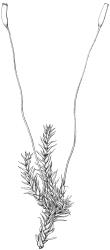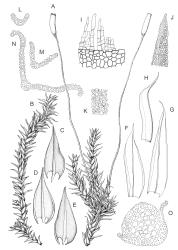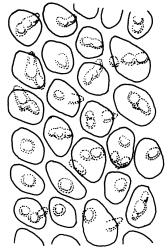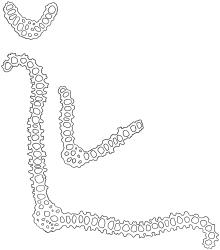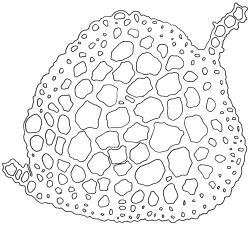- ≡ Didymodon papillatus Hook.f. & Wilson, London J. Bot. 3: 544 (1844)
- = Triquetrella filiformis Müll.Hal., Österr. Bot. Z. 47: 422 (1897)
Plants yellow-green above, brown below, forming often extensive interwoven mats of terete shoots on soil or rock. Stems red, bearing sparse, smooth brown rhizoids, in cross-section round-triangular, with central strand absent or small, sclerodermis present. Leaves in 3 distinct ranks that spiral around the stem, widely spreading from a ± sheathing base when moist, erect and closely appressed with occasional apices diverging when dry, 1.0–1.5 mm, ovate-triangular, carinate, acute to acuminate, strongly decurrent; margins variably recurved, crenulate from bulging cells and papillose; upper laminal cells obscure, round-rhombic, thick-walled, thicker in corners, (7.5–)9.0–13.5(–15) × 7.5–9.0(–13.5) µm, papillose with 1 or 2 high, spinose or bifid papillae; marginal cells not differentiated; lower laminal cells elongate in a small group adjacent to the costa. Costa concolorous, failing below the apex or percurrent. Laminal KOH colour reaction yellow.
Dioicous? Perichaetia terminal and lateral, perichaetial leaves enlarged and conspicuously sheathing the setae, abruptly narrowed to a reflexed, acuminate apex, with laminal cells weakly papillose. Perigonia (from Tasmanian material) in clusters at shoot apex, with bracts obtuse to acuminate. Setae very slender, flexuose, 12–16 mm. Capsules slightly asymmetric, long-cylindric, c. 1.5 mm. Operculum bluntly rostrate with a curved beak, c. ⅓ the theca length. Peristome with straight teeth, c. 180 µm, obscurely and obliquely striolate. Spores 13–17 µm, weakly papillose.
Wilson 1854, pl. 85, fig. 2 (as Didymodon papillatus); Brotherus 1901–1909, fig. 255 (A–G); Sainsbury 1955, pl. 28, fig. 4; Scott & Stone 1976, pl. 40; Beever et al. 1992, fig. 27; Zander 1993, pl. 28, figs 1–11; Malcolm et al. 2020, pp. 645–647.
The terete, filiform shoots with their leaves appressed when dry (but with occasional leaf tips diverging), and with red stems visible when moist, are characteristic of the species. Pseudoleskea imbricata also has appressed leaves when dry, but in that species the shoots are very smooth and julaceous. Leptodontium interruptum is superficially similar, may be found in similar habitats to T. papillata, and is often growing intermixed; the dry shoots of L. interruptum have leaf apices spreading. In addition, its leaf margins are undulate, and toothed near the apex (vs not undulate and without teeth in T. papillata).
NI: N Auckland, including offshore islands (HC, GB, RT), S Auckland, Gisborne, Hawke’s Bay, Taranaki, Wellington (incl. KA); SI: Nelson, Marlborough, Canterbury, Otago, Southland; St; Ch.
Australasian. Tasmania*, mainland Australia*.
In exposed sites, often in grassland or on sandy soil near sea beaches. This is a common species, but one that is only very rarely found fruiting. Plants with mature sporophytes and young perigonia were collected in Kowhai Grove, Rangitoto Island, on "bare ground in a canopy gap" in 1982 (AK 332724). In time the gap closed over, and by 2005 no Triquetrella papillata could be found at the now more shaded site. Commonly associated mosses are Ceratodon purpureus, Gertrudiella torquata, Hypnum cupressiforme, Leptodontium interruptum, Rosulabryum campylothecium, and Thuidiopsis furfurosa.
Records range in elevation from near sea-level to 760 m (Herbert, Otago L.D.).



